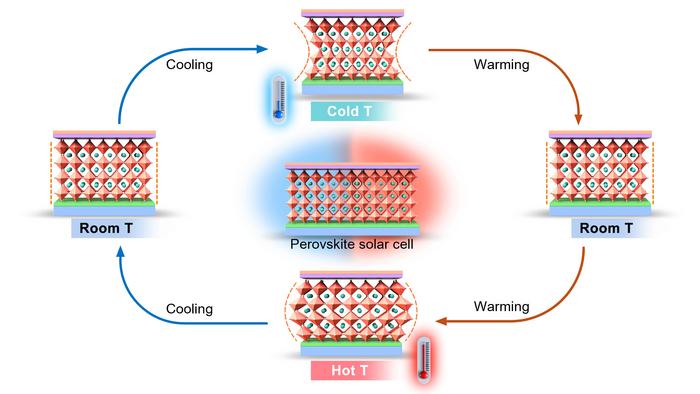
Perovskite solar cells present a compelling frontier in the renewable energy sector, balancing unprecedented efficiency with the promise of low-cost production methodologies. Yet, a critical obstacle remains: their stability. A recent collaborative investigation spearheaded by Professor Antonio Abate dives deep into this challenge, shedding light on the thermal vulnerabilities of metal-halide perovskites, the most notable subclass of these materials. Published in Nature Reviews Materials, the study articulates the detrimental impact of thermal cycling on perovskite microstructures and interfaces, ultimately paving the way toward sustainable enhancements in their longevity and viability.
As the scientific community grapples with the necessity for improved energy solutions, perovskite materials emerge as a tantalizing opportunity. They exhibit remarkable semiconducting qualities conducive to solar energy conversion, achieving efficiencies that have reached a peak of 27%. The potential for these materials to revolutionize the solar industry lies not only in their energy conversion performance but also in the reduced quantities of raw materials and energy required during their manufacture. This represents a seismic shift toward lower costs in solar technology, making renewable energy not just a dream, but a practical reality for broader adoption.
Nonetheless, despite their ability to outperform traditional silicon solar cells in controlled environments, perovskite cells face severe limitations when exposed to the realities of fluctuating weather conditions. Their lifespan remains considerably short in actual applications, prompting researchers to prioritize the establishment of durability metrics that align with those of conventional solar technologies. Research participants from a coalition comprising institutions from various countries, including China, Italy, Spain, and the UK, have dedicated years to revealing the intricacies at play in the thermal response of perovskite cells.
In real-world scenarios, perovskite solar modules endure a barrage of environmental variables, fluctuating significantly between extremes as they confront diverse climatic extremes. As articulated by Professor Abate, these modules must withstand seasonal changes and the kaleidoscope of effects from solar irradiation, nighttime cooling, and atmospheric factors throughout their operational lifespans. The stark contrast in climatic conditions demands that the encapsulation techniques currently employed offer robust protection from moisture and atmospheric agents yet still contend with pronounced temperature variances.
The study’s methodology utilized a rigorous approach to simulate the thermal abuse that these solar cells might encounter during their operational lifetime. Within this framework, researchers subjected the cells to extreme thermal cycling—ranging from minus 150 degrees Celsius to plus 150 degrees Celsius—repeatedly stressing the material beyond conventional expectations. By doing so, the aim was to replicate multi-dimensional impacts that real-world variability would impose on the cell’s structure and integrity, capturing significant changes that could catalyze material fatigue.
The outcomes of this investigation are characterized by their emphasis on the concept of thermal stress—a condition arising from these extreme temperature swings. This thermal stress manifests in dual forms: the internal stress within the perovskite layer itself and the stress that develops between adjacent layers composed of disparate materials. Such a phenomenon often results in inadequate adhesion as materials contract and expand differently in relation to temperature variations, which can lead to failure points at the interfaces between layers.
A critical aspect explored in this work revolves around the interactions between layers. In perovskite solar cells, the various materials—organic and inorganic—must maintain optimal contacts to ensure efficient charge transfer. Thermal stress reduces the effectiveness of these connections, leading to inefficiencies and potential breakdowns. The authors detail how localized phase transitions and the diffusion of elements during temperature cycling exacerbate these issues, making material integration and cohesion paramount for long-term performance.
In light of these findings, the research team has delineated strategies intended to bolster the resilience of perovskite solar cells against thermal degradation. One primary focus is enhancing the crystalline quality of the perovskite structures through refined fabrication techniques. Additionally, integrating suitable buffer layers capable of absorbing thermal stress and maintaining uniform connectivity between layers may prove vital for improving stability.
Moreover, establishing standardized testing protocols emerges as a pivotal recommendation. By advocating for uniform methodologies to assess thermal cycling stability, researchers can facilitate more reliable comparisons across different studies. This cooperative approach is critical for the scientific community to make measured advances in understanding and mitigating the vulnerability of these promising materials.
The implications of this research are enormous. The advancement of perovskite technology could lead to a profound transformation in the energy landscape. With fossil fuels at the forefront of climate change concerns, shifting toward sustainable energy sources has never been more urgent. The potential for cheaper solar technology could democratize access to renewable energy, particularly in underprivileged regions where energy costs are disproportionately high.
As insights from this study ripple through the scientific community, ongoing dialogue will be essential to fine-tune the balance between efficiency, stability, and overall performance. Researchers will be compelled to develop innovative solutions that ensure that perovskite cells can sustain their functionality over multi-decade timeframes, much like their silicon counterparts.
The synthesis of findings presented in this pivotal study signals a promising path forward in the development of more robust solar technologies ready to answer the global call for sustainable energy solutions. As the world stands on the edge of a renewable energy revolution, the lessons learned from examining the thermal performance of perovskite cells may hold the key to unlocking their full potential and establishing them as a dominant force in the solar energy market.
Subject of Research: Effects of thermal cycles on microstructures and interactions in perovskite solar cells
Article Title: Resilience Pathways for Halide Perovskite Photovoltaics Under Temperature Cycling
News Publication Date: 19-Feb-2025
Web References: Nature Reviews Materials
References: Not applicable
Image Credits: © Li Guixiang
Keywords
Perovskites, Thermal expansion, Microstructures, Solar energy, Thin films.
Tags: advancements in solar technologyenhancing longevity of solar cellsimproving efficiency of solar cell materialslow-cost solar energy productionmetal-halide perovskite vulnerabilitiesNature Reviews Materials publication on solar cellsperovskite materials in renewable energysemiconductor properties of perovskitesstability challenges in renewable energysustainable energy solutionsthermal cycling effects on perovskitesthermal stresses in perovskite solar cells





